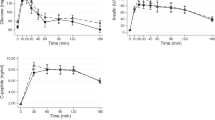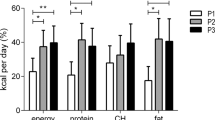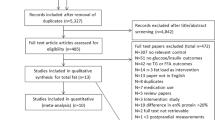Abstract
Background/Objective:
Early insulin secretion following a meal is representative for normal physiology and may depend on meal composition. To compare the effects of a fat-rich and a carbohydrate-rich mixed meal on insulinogenic index as a measure of early insulin secretion in normoglycemic women (NGM) and in women with type 2 diabetes mellitus (DM2), and to assess the relationship of anthropometric and metabolic factors with insulinogenic index.
Subjects/Methods:
Postmenopausal women, 76 with NGM and 64 with DM2, received a fat-rich meal and a carbohydrate-rich meal on separate occasions. Early insulin response was estimated as insulinogenic index (△insulin0–30 min/△glucose0−30 min) for each meal. Associations of fasting and postprandial triglycerides, body mass index, waist and hip circumference and alanine aminotransferase with insulinogenic indices were determined.
Results:
Women with NGM present with higher insulinogenic index than women with DM2. The insulinogenic index following the fat-rich meal (△I30/△G30 (fat)) was higher than the index following the carbohydrate-rich meal (△I30/△G30 (CH)) (P<0.05 in women with DM2, and not significant in women with NGM). In women with DM2, homeostasis model assessment for insulin resistance was positively associated with △I30/△G30 (CH). In women with NGM, waist circumference was independently and inversely associated with △I30/△G30 (fat) and with △I30/△G30 (CH); hip circumference was positively associated with △I30/△G30 (fat).
Conclusions:
The insulinogenic index following the fat-rich meal was higher than following the isocaloric carbohydrate-rich meal, which might favorably affect postprandial glucose excursions, especially in women with DM2. The association between a larger waist circumference and a lower meal-induced insulinogenic index in women with NGM requires further mechanistic studies.
This is a preview of subscription content, access via your institution
Access options
Subscribe to this journal
Receive 12 print issues and online access
$259.00 per year
only $21.58 per issue
Buy this article
- Purchase on Springer Link
- Instant access to full article PDF
Prices may be subject to local taxes which are calculated during checkout


Similar content being viewed by others
References
Alberti KG, Zimmet PZ (1998). Definition, diagnosis and classification of diabetes mellitus and its complications. Part 1: diagnosis and classification of diabetes mellitus provisional report of a WHO consultation. Diabet Med 15, 539–553.
Alssema M, Schindhelm RK, Dekker JM, Diamant M, Kostense PJ, Teerlink T et al. (2007). Postprandial glucose and not triglyceride concentrations are associated with carotid intima media thickness in women with normal glucose metabolism: the Hoorn prandial study. Atherosclerosis, doi:10.1016/j.atherosclerosis.2006.12.021.
Bergmeyer HU, Horder M, Rej R (1986). International Federation of Clinical Chemistry (IFCC) Scientific Committee, Analytical Section: approved recommendation (1985) on IFCC methods for the measurement of catalytic concentration of enzymes. Part 3. IFCC method for alanine aminotransferase (L-alanine: 2-oxoglutarate aminotransferase, EC 2.6.1.2). J Clin Chem Clin Biochem 24, 481–495.
Carpentier A, Mittelman SD, Bergman RN, Giacca A, Lewis GF (2000). Prolonged elevation of plasma free fatty acids impairs pancreatic beta-cell function in obese nondiabetic humans but not in individuals with type 2 diabetes. Diabetes 49, 399–408.
Carpentier A, Mittelman SD, Lamarche B, Bergman RN, Giacca A, Lewis GF (1999). Acute enhancement of insulin secretion by FFA in humans is lost with prolonged FFA elevation. Am J Physiol 276, E1055–E1066.
Carpentier A, Zinman B, Leung N, Giacca A, Hanley AJ, Harris SB et al. (2003). Free fatty acid-mediated impairment of glucose-stimulated insulin secretion in nondiabetic Oji-Cree individuals from the Sandy Lake community of Ontario, Canada: a population at very high risk for developing type 2 diabetes. Diabetes 52, 1485–1495.
Caumo A, Luzi L (2004). First-phase insulin secretion: does it exist in real life? Considerations on shape and function. Am J Physiol Endocrinol Metab 287, E371–E385.
Deans KA, Sattar N (2006). Anti-inflammatory’ drugs and their effects on type 2 diabetes. Diabetes Technol Ther 8, 18–27.
Del Prato S (2003). Loss of early insulin secretion leads to postprandial hyperglycaemia. Diabetologia 46 (Suppl 1), M2–M8.
Del Prato S, Tiengo A (2001). The importance of first-phase insulin secretion: implications for the therapy of type 2 diabetes mellitus. Diabetes Metab Res Rev 17, 164–174.
Eldor R, Raz I (2006). Lipotoxicity versus adipotoxicity—the deleterious effects of adipose tissue on beta cells in the pathogenesis of type 2 diabetes. Diabetes Res Clin Pract 74 (Suppl 1), S3–S8.
Festa A, Williams K, D’Agostino Jr R, Wagenknecht LE, Haffner SM (2006). The natural course of beta-cell function in nondiabetic and diabetic individuals: the Insulin Resistance Atherosclerosis Study. Diabetes 55, 1114–1120.
Gannon MC, Nuttall FQ (2006). Control of blood glucose in type 2 diabetes without weight loss by modification of diet composition. Nutr Metab (London) 3, 16.
Gentilcore D, Chaikomin R, Jones KL, Russo A, Feinle-Bisset C, Wishart JM et al. (2006). Effects of fat on gastric emptying of and the glycemic, insulin, and incretin responses to a carbohydrate meal in type 2 diabetes. J Clin Endocrinol Metab 91, 2062–2067.
Grodsky GM (1972). A threshold distribution hypothesis for packet storage of insulin and its mathematical modeling. J Clin Invest 51, 2047–2059.
Jenkins DJ, Wolever TM, Taylor RH, Barker H, Fielden H, Baldwin JM et al. (1981). Glycemic index of foods: a physiological basis for carbohydrate exchange. Am J Clin Nutr 34, 362–366.
Kahn SE (2003). The relative contributions of insulin resistance and beta-cell dysfunction to the pathophysiology of type 2 diabetes. Diabetologia 46, 3–19.
Kahn SE, Prigeon RL, McCulloch DK, Boyko EJ, Bergman RN, Schwartz MW et al. (1993). Quantification of the relationship between insulin sensitivity and beta-cell function in human subjects. Evidence for a hyperbolic function. Diabetes 42, 1663–1672.
Krezowski PA, Nuttall FQ, Gannon MC, Bartosh NH (1986). The effect of protein ingestion on the metabolic response to oral glucose in normal individuals. Am J Clin Nutr 44, 847–856.
MacIntosh CG, Holt SH, Brand-Miller JC (2003). The degree of fat saturation does not alter glycemic, insulinemic or satiety responses to a starchy staple in healthy men. J Nutr 133, 2577–2580.
Mari A, Ahren B, Pacini G (2005). Assessment of insulin secretion in relation to insulin resistance. Curr Opin Clin Nutr Metab Care 8, 529–533.
Matthews DR, Hosker JP, Rudenski AS, Naylor BA, Treacher DF, Turner RC (1985). Homeostasis model assessment: insulin resistance and beta-cell function from fasting plasma glucose and insulin concentrations in man. Diabetologia 28, 412–419.
Matthews JN, Altman DG, Campbell MJ, Royston P (1990). Analysis of serial measurements in medical research. BMJ 300, 230–235.
Mooy JM, Grootenhuis PA, de Vries H, Valkenburg HA, Bouter LM, Kostense PJ et al. (1995). Prevalence and determinants of glucose intolerance in a Dutch Caucasian population. The Hoorn Study. Diabetes Care 18, 1270–1273.
Nauck MA, Niedereichholz U, Ettler R, Holst JJ, Orskov C, Ritzel R et al. (1997). Glucagon-like peptide 1 inhibition of gastric emptying outweighs its insulinotropic effects in healthy humans. Am J Physiol 273, E981–E988.
Nijpels G, van der Wal PS, Bouter LM, Heine RJ (1994). Comparison of three methods for the quantification of beta-cell function and insulin sensitivity. Diabetes Res Clin Pract 26, 189–195.
Nuttall FQ, Mooradian AD, Gannon MC, Billington C, Krezowski P (1984). Effect of protein ingestion on the glucose and insulin response to a standardized oral glucose load. Diabetes Care 7, 465–470.
Owens DR, Luzio SD, Ismail I, Bayer T (2000). Increased prandial insulin secretion after administration of a single preprandial oral dose of repaglinide in patients with type 2 diabetes. Diabetes Care 23, 518–523.
Paolisso G, Gambardella A, Amato L, Tortoriello R, D’Amore A, Varricchio M et al. (1995). Opposite effects of short- and long-term fatty acid infusion on insulin secretion in healthy subjects. Diabetologia 38, 1295–1299.
Poitout V, Robertson RP (2002). Minireview: secondary beta-cell failure in type 2 diabetes—a convergence of glucotoxicity and lipotoxicity. Endocrinology 143, 339–342.
Pratley RE, Weyer C (2001). The role of impaired early insulin secretion in the pathogenesis of type II diabetes mellitus. Diabetologia 44, 929–945.
Prentki M, Corkey BE (1996). Are the beta-cell signaling molecules malonyl-CoA and cystolic long-chain acyl-CoA implicated in multiple tissue defects of obesity and NIDDM? Diabetes 45, 273–283.
Raz I, Eldor R, Cernea S, Shafrir E (2005). Diabetes: insulin resistance and derangements in lipid metabolism. Cure through intervention in fat transport and storage. Diabetes Metab Res Rev 21, 3–14.
Robertson RP, Harmon J, Tran PO, Poitout V (2004). Beta-cell glucose toxicity, lipotoxicity, and chronic oxidative stress in type 2 diabetes. Diabetes 53 (Suppl 1), S119–S124.
Seltzer HS, Allen EW, Herron Jr AL, Brennan MT (1967). Insulin secretion in response to glycemic stimulus: relation of delayed initial release to carbohydrate intolerance in mild diabetes mellitus. J Clin Invest 46, 323–335.
Steil GM, Hwu CM, Janowski R, Hariri F, Jinagouda S, Darwin C et al. (2004). Evaluation of insulin sensitivity and beta-cell function indexes obtained from minimal model analysis of a meal tolerance test. Diabetes 53, 1201–1207.
Tura A, Kautzky-Willer A, Pacini G (2006). Insulinogenic indices from insulin and C-peptide: comparison of beta-cell function from OGTT and IVGTT. Diabetes Res Clin Pract 72, 298–301.
van Loon LJ, Saris WH, Verhagen H, Wagenmakers AJ (2000). Plasma insulin responses after ingestion of different amino acid or protein mixtures with carbohydrate. Am J Clin Nutr 72, 96–105.
Voorlichtingsbureau voor de Voeding (2001) NEVO Table Netherlands (Dutch Nutrient Database).
Weyer C, Bogardus C, Mott DM, Pratley RE (1999). The natural history of insulin secretory dysfunction and insulin resistance in the pathogenesis of type 2 diabetes mellitus. J Clin Invest 104, 787–794.
Acknowledgements
This research was financially supported by a grant from the Dutch Diabetes Research Foundation (grant no. 2001.00.052) and by funding from Novartis International AG, Switzerland.
Author information
Authors and Affiliations
Corresponding author
Additional information
Contributors: JMD and RJH were responsible for the design and funding of the study. GN was responsible for recruitment and management of the patients with DM2. MA and RKS were responsible for acquisition of the data; MA performed statistical analyses and is the first author. JMR advised on interpreting the data. PJK provided advise for statistical analyses. TT and all of the other authors provided input in writing the manuscript.
Rights and permissions
About this article
Cite this article
Alssema, M., Schindhelm, R., Rijkelijkhuizen, J. et al. Meal composition affects insulin secretion in women with type 2 diabetes: a comparison with healthy controls. The Hoorn prandial study. Eur J Clin Nutr 63, 398–404 (2009). https://doi.org/10.1038/sj.ejcn.1602953
Received:
Revised:
Accepted:
Published:
Issue Date:
DOI: https://doi.org/10.1038/sj.ejcn.1602953
Keywords
This article is cited by
-
Association of high carbohydrate versus high fat diet with glycated hemoglobin in high calorie consuming type 2 diabetics
Journal of Diabetes & Metabolic Disorders (2013)



